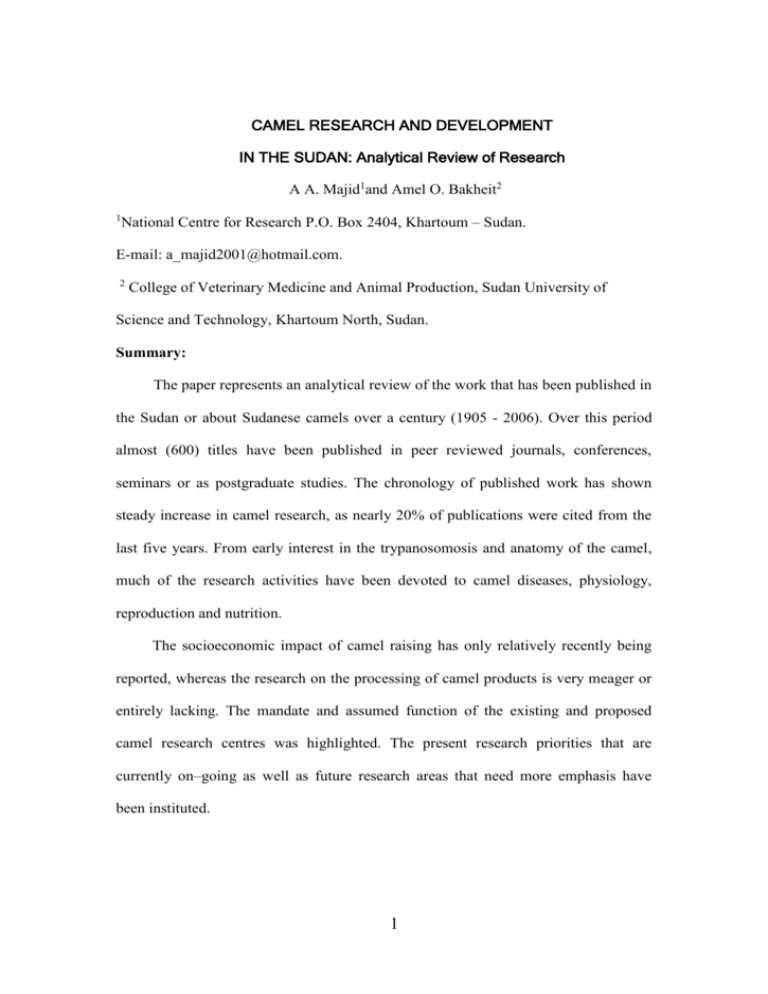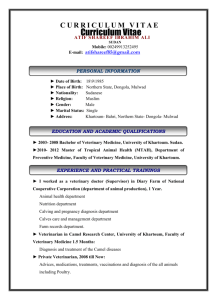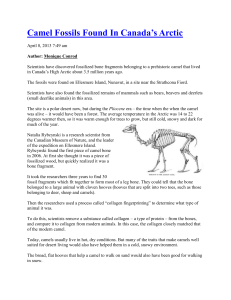Default Normal Template - Sudan University of Science and
advertisement

CAMEL RESEARCH AND DEVELOPMENT IN THE SUDAN: Analytical Review of Research A A. Majid1and Amel O. Bakheit2 1 National Centre for Research P.O. Box 2404, Khartoum – Sudan. E-mail: a_majid2001@hotmail.com. 2 College of Veterinary Medicine and Animal Production, Sudan University of Science and Technology, Khartoum North, Sudan. Summary: The paper represents an analytical review of the work that has been published in the Sudan or about Sudanese camels over a century (1905 - 2006). Over this period almost (600) titles have been published in peer reviewed journals, conferences, seminars or as postgraduate studies. The chronology of published work has shown steady increase in camel research, as nearly 20% of publications were cited from the last five years. From early interest in the trypanosomosis and anatomy of the camel, much of the research activities have been devoted to camel diseases, physiology, reproduction and nutrition. The socioeconomic impact of camel raising has only relatively recently being reported, whereas the research on the processing of camel products is very meager or entirely lacking. The mandate and assumed function of the existing and proposed camel research centres was highlighted. The present research priorities that are currently on–going as well as future research areas that need more emphasis have been instituted. 1 Introduction: According to very reserved estimates, camel population in the Sudan is about 3.7 million, raised mainly in a belt north of 12o N latitude (Fig.1). The most densely populated areas are Kordofan, Eastern and Darfur states, followed by other regions in the central and Northern provinces. The camels are owned mainly by transhumant pastoralists as a source of milk and meat as well as pack and riding animal. Over decades, extensive research has been conducted on Sudanese camels. The development of the camel research in the different research institutions may be summarized as follows: 1902 - 1970: The first three decades of this period (1902 – 1927) are regarded as the period of establishment of veterinary services in the Sudan. The main thrust of camel research during the period was directed to camel trypanosomiasis diagnosis and treatment. A formal gel diagnostic test was developed in 1923 and mercuric chloride was described by Bennett (1928). A major landmark during this period was the establishment of the Veterinary School in 1938. Helminth parasites of the camel were recorded by Malik (1959). Interest in the camel anatomy was initiated by Kanan (1973) who devoted much of his time and effort to the anatomy of the camel. This period was characterized by camel research on anatomy, morphology and histology (Arnautovic and Abdalla, 1969). Blood and milk constituents and endocrinology were studied by Holler and Hassan (1965). Camel’s husbandry was 2 described by Gillespie (1962). The status of trypanosomosis was reviewed by Karib (1961). 1971 - 1980: About 25% of the camel research and studies were conducted during this period. The major areas covered were camel reproduction (Musa 1980) camel endocrinology, enzymes and haematology research were continued (Harvey and Obeid 1974; Tartour, 1971). The end of the seventies witnessed the increased awareness of the camel as an important animal in arid and semi-arid areas. Considerable information on its research and studies was collected and exchanged through the International Foundation for Sciences (IFS) workshop on camels in Khartoum in 1979, the Arab Organization for Agricultural Development (AOAD) workshop on camels in the Arab countries (1980). 1981 - 1990: About 45% of camel research and studies were published during this period. This increase could be attributed to the establishment of the Camel Research Unit at the Faculty of Veterinary Science. The major areas were camel diseases, physiology, production, reproduction, anatomy, and camel nomadism. The period was characterized by documentation of camel research and studies: ACSAD Camelid Bibliography, (Farid, 1981,), UNSO Analytical and Annotated Bibliography (Wilson et al, 1990). The Camel Newsletter was published by ACSAD and the camel Network was established. The Camel Research Project was implemented at the Faculty of Veterinary Science, University of Khartoum. 3 1991 - 2000: About 13% of the camel research and studies were published during this period. The majority of these studies were diseases, husbandry, economics and reproduction. The implementation of Butana Project contributed substantially to nutrition, diseases, herd dynamics and socio-economics of camel herders. Brucella abortus biovar 3 was reported for the first time by Agab et al (1994). Seasonal morbidity and mortality and camel calf diarrhoea among camels was studied by Agab (1993). Studies on the socio-economics of camels were reported by Sakr and Majid (2000,). The period was characterized by the establishment of the National Camel Research and Development Committee, The National Council for Camel Research and Development, The Butana Camel Research Project in El Shuwak, The Camel Research Centres in Tambul and El Rahad, the ACSAD Camel Research conference in Khartoum which was followed by the establishment of Camel Applied Research and Development Network in the Sudan. 2000-2006: About (118) research studies were executed during this period as Ph.D. theses (60) or research articles (58). This is almost 18% of the entire published work on camels in the Sudan. Studies to elucidate the causes of camel calf diarrhea were executed during this period. Such studies have identified Toxoplasma gondii (Ishag et al., 2006), Sarcocystis (Ishag, et al, 2005), Rotavirus (Ali, et al 2006) and Clostridium perfringes (Abbas, 2004) as potential causes of this syndrome. Helminth surveys 4 (Azrag, 2005), hydatidosis (Osman, 2004) , molecular diagnosis of Trypanosoma evansi ( Aradaib and Majid , 2005 ) and camel mastitis (Ismail, 2006) have been investigated. Production parameters (Ali and Majid, 2006) and endocrinology and hepatic trace elements ( Amel, 2006 ) were also reported during this period as well as the use of finger print in typing the different camel types in the Sudan ( Mohamed , 2005 ). A study on camel marketing was published during this period (Idris, 2003) as well as more studies were conducted on the socioeconomic of camel raising (Sakr and Majid, 2002). Camel Research and Development Institutions: -Sudan Veterinary Services:The first institute dealing with camel research as early as 1902 was the Sudan Veterinary Services. The emphasis of SVS was research on camel diseases, mainly trypanosomiasis. The activity was passed on to the Central Veterinary Laboratory which was established at the beginning of the century and later on to the Central Veterinary Research Laboratories and its regional laboratories. Faculty of Veterinary Science, University of Khartoum: The Faculty of Veterinary Science started as a Veterinary School in 1938 and developed into a Faculty of Veterinary Science in the University of Khartoum. The Faculty conducted research on the basic sciences of camel such as anatomy, morphology, histology, histochemistry, biochemistry, physiology, husbandry, nutrition, pathology, parasitology, epidemiology, reproduction and production. 5 Camel Research Unit (CRU), University of Khartoum: A camel research unit was established in the Faculty of Veterinary Science, University of Khartoum in April 1983 as a joint activity between Sudanese and French scientists. It started functioning in October1983. The (CRU) is a multidisciplinary unit covering camel basic sciences and the socio-economic studies of camel owners and herd dynamics. Camel Research and Development Council: The (CRDC) was established in the Ministry of Animal Resources in 1992/93. The objectives of (CRDC) were: - To formulate camel research policies. - Coordination of camel research in the universities and research institutions and improvement of services to camel raisers. - Increase awareness of the importance of the camel as meat and milk animal. - Encouragement of scientists and establishment of links between them at national and international levels. The (CRDC) conducted surveys and studies and identified five areas as camel research centres: El Showak, El Rahad, Um Shadidah, Tambul and Kutum. El Showak Camel Research Centre: This centre is located in Gedaref State at 14o3 N and 35o8’ E. The centre was established in 1987 as a joint project between France Tropical Veterinary Institute of Paris and the Camel Research Unit at the University of Khartoum as off-shoot of camel farming systems in the Butana area. 6 In 1989 a detailed study was conducted by Sudanese scientists and the French counterparts and a technical aid was offered to the centre to conduct research and studies. The major objectives of the Centre were: - Encouragement of camel research studies in the Butana area. - Range rehabilitation and management. - Improvement of camel farming systems. - Improvement of camel veterinary services. El Rahad Camel Research Centre: The centre is established in El Rahad, Northern Kordofan. The objectives of the centre were: - Survey of camel production, reproduction, husbandry systems and disease problems. - Studies on the socio-economic of camels in Northern Kordofan State. - Cooperation with scientists working on camels in the area. - Range management and camel grazing patterns. - Effects of camel grazing on Gum Arabic. Tambul Camel Research Centre: This is located in Tambul in Gezira State in Central Sudan. The objectives of the centre are: - Survey of camel production, reproduction and husbandry systems. - On-station research on diseases caused by parasites, bacteria, viruses and ectoparasites 7 Studies on the production and reproduction parameters in the region. The Camel Applied Research and Development Network (CARDN): (CARDN) was established in ACSAD in 1996 with support from IFAD and the French government. Sudan has joined the network in January 1997. The following represents research proposals that were approved by CARDN. Some of these projects have been successfully completed while others are at a very beginning stage. Implemented Research: Socio-economic studies: This project was implemented as information obtained from owner survey. A special questionnaire had been designed for this purpose. The data obtained included herd size, herd structure, herd movement, type of husbandry, nutrition and supplementary feeding , annual income, management problems, diseases, available veterinary services, health and education. The data were collected from owners and herders in Eastern Sudan, Kordofan and Darfur and appeared as publications from ACSAD (Sakr and Majid. 2000, 2002). Causes and Epizootiological Studies on Camel Calf Diarrhoea: Over recent years there was upsurge and excitement on studies and investigations on problems related to health, productivity and other matters related to this animal species. The general belief was that the camel is susceptible to infections caused by viruses and less so by bacterial and fungal infections However, some camel diseases are known to be due to specific bacteria, viruses or parasites while other conditions need to be thoroughly investigated to ascertain the causative agent (s). 8 One such important condition is the camel calf diarrhoea. This syndrome is quite prevalent and some workers believe that it is one of the major causes of the reduced herd growth observed in camels. The causes of this syndrome could be diverse from infectious, nutritional or due to the type of husbandry and certain nomadic practices. The wide scope of the problem should, therefore, include different fields of study. Study of the Prevalence of Hydatidosis in Camel Populations in the Sudan and the Use of Immunodiagnostic Techniques in Detecting the Condition: Echinococcosis / hydatidosis which is one of the veterinary important public health hazards include the camel as one of the intermediate hosts. From recent studies it had been evident that the prevalence in camels is much higher than in other animal species in the same locality. Also the viability and infectivity of proscolices from camels are high. This work aimed at: - Study on the prevalence of hydatid cysts in camels in different parts of the country. - Assess infection in dogs and /or wild canidae in the different areas. - Collect serum samples for the serological testing to affirm the specificity and sensitivity of the tests used. - To formulate a practical and sound control programme for the disease. Studies on Mastitis in Camels: Causative Agent(s) and Epizootiology: In addition to its animal health significance, mastitis has economic and public health implications. The reduction in milk production from affected quarters, culling 9 due to udder infection, rendering of milk unsuitable for consumption and its effects on calf feeding are the main prominent losses due to camel mastitis. The lack of information on this disease in the Sudan has stimulated its investigation. The study was designed to determine the incidence of the disease mainly by field surveys, clinical examinations and laboratory methods. However, limited work has so far been carried out on camel mastitis (Ismail, 2006). Future research: In spite of the extensive research activities carried out on the camel, there are some areas that need more emphasis. More attention was given to diseases and less so to production and reproduction. For future prospects the following areas of research may be instituted: 1- More in-depth research on the aetiology of camel calf diarrhea and mortality is needed. The role of the causative agents so far identified (Toxoplasma, Rotavirus and Clostridium perfringens) have to be fine-tuned and the relative importance of them should be precisely confirmed. Other causes such as management and nutritional factors as major or predisposing factors have to be investigated. 2- Productions parameters in the free-range or intensive systems (as in areas where agricultural and industrial byproducts are used) need to be studied. 3- Processing of camel products such as meat, milk, hides and hair are important value added commodities. Our socioeconomic studies have shown that large amounts of milk are wasted after the consumption of some milk in the pastoral areas. As for hides and hair there is limited use of them in traditional 10 household necessities and the literature on the processing of these products is very meagre or lacking. These research activities have to be coupled with studies on camel marketing opportunities and constraints 4- Breeding studies are almost lacking. There is good potential for race camels, meat and milk types that their upgrading by selection and cross-breeding is urgent. 5- In the published literature over decades, it was evident that viral and bacterial diseases are a major threat for the herd growth and productivity. It is, therefore, imperative to undertake research efforts towards the covarge of camels by the vaccination campaigns in order to protect them from these diseases. 6- On- farm and on- field research activities are needed in the three existing camel research centers (ELshwak, Tambol and ElRahad). The establishment of other centers in Kutum, Umshadeda and the red sea will provide wider covarge of conducting research on camels in their major raising areas in the Sudan. 11 Fig. 1: Camel Distribution in the Sudan and Camel Research Centres (*) Wadi Halfa Port Sudan Kassala Khartoum * EL-Fasher * El rahad El-genena El-obeid Nyala Wau Juba 12 Tambul * El shwak References Abbas, Zakia, M. A. (2004) The Role of Clostridium perfringens in camel calf diarrhea in the Sudan with special reference on the pathogenesis and pathological changes. Ph. D., University of Khartoum Agab, H. (1993). Epidemiology of camel diseases in Eastern Sudan with emphasis on brucellosis. M.V.Sc. Thesis University of Khartoum. Agab, H. Abbas, B.; El Jack Ahmed, H.; Mamoun, I.E. (1994) First report on the isolation of Brucella abortus biovar 3 from camel (Camelus dromedarius) in the Sudan. Rev. Elev. Med. Vet. Pays. Trop. 47(4): 361. Ali, Y.H.; Khalafalla, A.I., Gaffar, M. E.; Peenze,I. and Steele, A. D. ( 2006 ) . Progress in research on viral diseases of camels, isolation of group a rota virus. The 1st Conference of the International Society of Camelids Research and Development (ISOCARD) Al Ain, UAE, 15-17 April, 2006. Ali, M. S. and Majid, A. A. (2006). Some production parameters of camels in the Butana area, Sudan. International Conference on Camels. Al Qassim, KSA, 912, May, 2006. Amel, O. Bakheit (2006) some trace elements in the liver of camels, cattle, sheep and goats. The 1st Conference of the International Society of Camelids Research and Development (ISOCARD) Al Ain, UAE, 15-17 April, 2006. AOAD (1980). A study of camels in Arab world (Phase II) Technique and Economic Feasibility study of Establishment of camel Ranches in the Sudan (jointly with ACSAD). 13 Aradaib, I. E., and Majid, A.A (2005). A simple and rapid method for detection of Trypansoma evansi in the dromedary camel using a nested polymerase chain reaction. Res Vet Sci. 87, 34-41 Arnautovic, I. and Abdella, O. (1969). The elastic structure of the foot of the camel. Acta Anat., 72(3): 411 - 428. (Resume in Vet. Bull., 1970, 40(7): No. 3680). Azrag, A. F. A. (2005). Epidemiology of gastrointestinal Helminthes among Dromedary camels at North Darfur natural pastures. M.V.Sc. University of Bahr el Ghazal Bennett, S.C.J. (1928). The mercuric chloride as diagnostic agent for trypanosomiasis in camels. J. Comp. Path. Therap, 41: 341 - 353. Farid, M.F(1981) Camilids Bibliography, The Arab Centre for the Studies of Arid zones and Dry Lands ( ACSAD), AS-P15-1981 Gillespie, I.A. (1962). Riding camels of the Sudan. Sud. J. Vet. Sci., & Anim. Husb., 3: 37 - 42. Harvey, D.G. and Obeid, H.M.A. (1974). The application of certain liver function tests including serum alkaline phosphatase estimation to domesticated animals in the Sudan. British Vet. Journal, 130(6): 544 - 555 Holler H. and Hassan, Y.M. (1965). The amino-acid composition camel milk casein. Sud. J. Vet. Sci., Anim. Husb. 6(1): 60 - 63. Idris B. (2003). Marketing of camels in the Sudan. 111/2003. 14 CARD/ACSAD/Camel/P Ishag, Manal Y. Majid, A.A. and Alkan, M. E. (2005) Effects of Sarcocystis cameli on experimentally infected camels .Sud.J.Sci.Res. : 9(1) 70-80 Ishag, Manal,Y Magzoub, M.E. and Majid, A.A. (2006): Detection of Toxoplasma gondii tachyzoites in the milk of experimentally infected lactating she-camels. Journal of Animal and Veterinary Advances (JAVA) 5(8). Ismael, M.A.A. (2006): Epidemiological Study on camel mastitis in North Kordofan State. M.Sc. University of Khartoum Kanan, C.V. (1973): “Observations on the arterial supply to the hip joint of Camels dromedarius “. Acta Morpho. Neerl and Scand. 11: 209 - 214. Karib, E.A. (1961). Animal trypanosomiasis in Sudan. Sud. J. Vet. Sci., Anim. Husb. 2(1): 39 - 46. Malek (1959): Helminthes parasites of the camel (C.dromedarias) in the Sudan. Parasit. 42(2) 38-39. Mohamed, Layla, Ismail (2005) Immune responses to Brucella vaccine and genetic diversity of Sudanese camels (Camelus dromedarius) Musa, B.E. (1980): “Reproductive patterns in the female camel (Camelus dromedarius) IFS Workshop on camels, Khartoum, Sudan 15 - 20 Dec. 1979) Osman M.O. (2002): Sero-epidemiological studies on camel hydatidosis MV.Sc., Thesis. University of Khartoum. Sakr, I and Majid, A.A (2000): The Socioeconomic of camel herders in Kordofan. The Camel Applied Research CARDN/ASCAD/CAMEL/P94/2000. 15 and Development Network Sakr, I., H and Majid, A.A. (2002): The socioeconomic of camel herders in Sudan. CARDN/ACSAD/camel/P120/2002. Tartour, G. (1971): “Studies on the haemogram of the adult dromedary camel”. Vet. Med. J. Cairo. 19: 353 - 361. Wilson, T, Araya, A and Melaku, A. (1990): the one humped camel: on analytical and annotated bibliography (1980-1989), UNSD technical publications. Partridge Partners, Umberleigh, North Devon, UK. 16

![KaraCamelprojectpowerpoint[1]](http://s2.studylib.net/store/data/005412772_1-3c0b5a5d2bb8cf50b8ecc63198ba77bd-300x300.png)






